Process of Wastewater Treatment Plant
PROCESS OF WASTEWATER TREATMENT PLANT :
Wastewater enters the treatment plant
First it goes through a fine screen, next to aerated grit chamber, and then enters the primary clarifier. Sludge settled in the primary clarifier is sent to the fermenters and then to digesters.
First it goes through a fine screen, next to aerated grit chamber, and then enters the primary clarifier. Sludge settled in the primary clarifier is sent to the fermenters and then to digesters.
After the primary treatment, wastewater flows into (BNR)
bioreactors.
The activated sludge is separated in the following secondary
clarifier. The clear effluent flows into Ultraviolet (UV),
then to River. Settled activated sludge in the secondary
clarifier is pumped back to BNR.
Excess sludge is pumped into the dissolved air floatation (DAF)
unit for thickening.
Wastewater is collected in sanitary sewers (a complex
network of underground pipes). Upon reaching the treatment
plant, the wastewater flows through a series of treatment
processes which remove the wastes from the water. Each step
the water becomes cleaner.
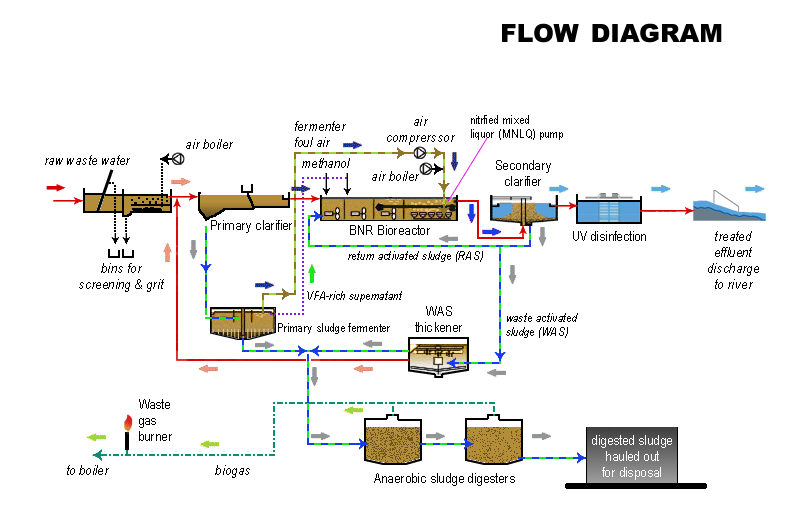
Grit Removal
In the grit chamber, heavy particles, such as a small stones, eggs shells, and coffee grounds settle to the bottom and are removed. These abrasive materials can damage pumps and cause equipment to fail prematurely the grit is removed and washed in the grit classifier before it is properly disposed.
Preliminary Treatment
Bar screens catch rags, sticks, plastic containers, and other objects floating in these large items are removed so that they do not clog pumps or interfere with other equipment process.
In the grit chamber, heavy particles, such as a small stones, eggs shells, and coffee grounds settle to the bottom and are removed. These abrasive materials can damage pumps and cause equipment to fail prematurely the grit is removed and washed in the grit classifier before it is properly disposed.
Preliminary Treatment
Bar screens catch rags, sticks, plastic containers, and other objects floating in these large items are removed so that they do not clog pumps or interfere with other equipment process.
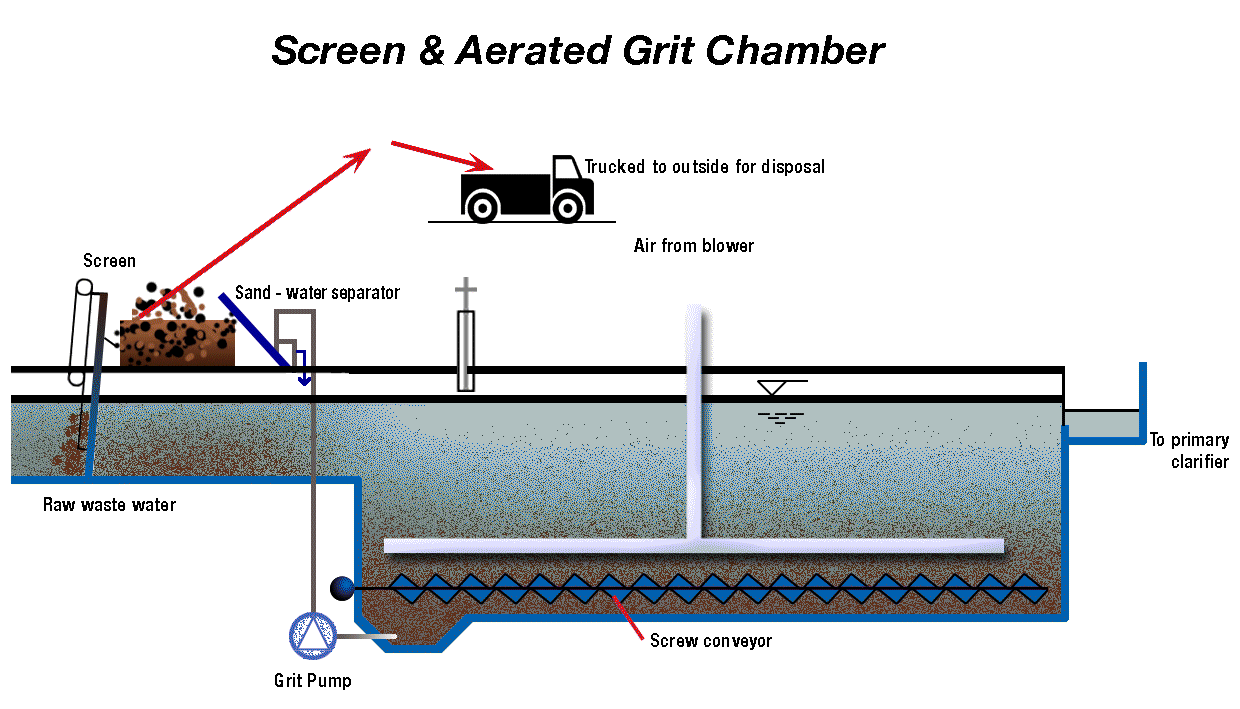
Primary sedimentation tank
In the primary sedimentation or "settling" tank, heavier solids are given time to sink to the bottom. These solids called "primary sludge" are sucked out of the bottom of the tank. They are sent to a digester for further treatment. Oil, grease, and other scum that float of the wastewater are skimmed off and may be sent to the digester.
In the primary sedimentation or "settling" tank, heavier solids are given time to sink to the bottom. These solids called "primary sludge" are sucked out of the bottom of the tank. They are sent to a digester for further treatment. Oil, grease, and other scum that float of the wastewater are skimmed off and may be sent to the digester.
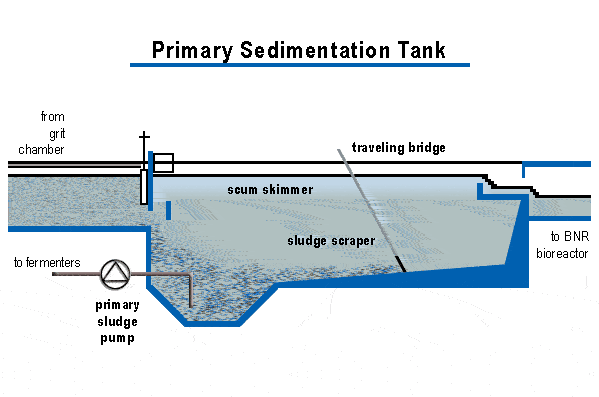
Fermenters
The fermenters are large and closed tanks with a rotating stirring mechanism. Sludge is fermented to produce the volatile fatty acids (VFAs) .The residual sludge along with scum is pumped to the sludge digesters . The foul air also functions as a supplementary air supply for the bioreactors.
The fermenters are large and closed tanks with a rotating stirring mechanism. Sludge is fermented to produce the volatile fatty acids (VFAs) .The residual sludge along with scum is pumped to the sludge digesters . The foul air also functions as a supplementary air supply for the bioreactors.
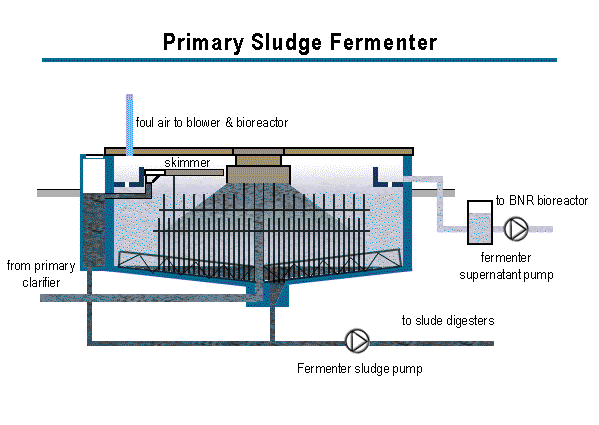
Dissolved air floating (DAF) tank
Waste activated sludge is thickened in dissolved air floatation (DAF) tank to reduce the volume of sludge.
Under the effect of air bubbles flowing upwards, the sludge solids are carried to surface and skimmed out.
Waste activated sludge is thickened in dissolved air floatation (DAF) tank to reduce the volume of sludge.
Under the effect of air bubbles flowing upwards, the sludge solids are carried to surface and skimmed out.
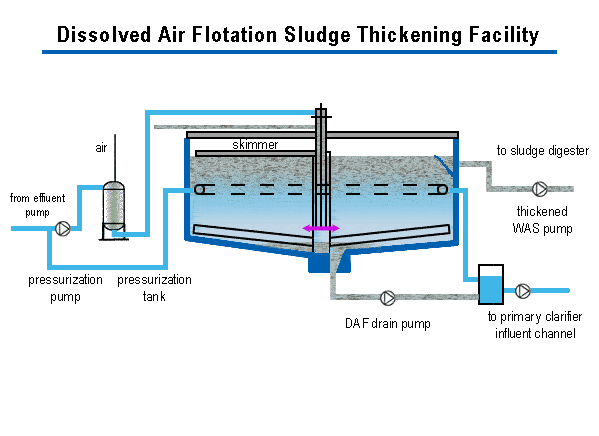
Anaerobic Sludge Digester
Anaerobic digestion is biological process which break down a significant amount of organic solids in the sludge and at the same time produces methane gas
Anaerobic digestion is biological process which break down a significant amount of organic solids in the sludge and at the same time produces methane gas

BNR bioreactors
The bioreactor is divided into several cells. In some cells, air/ oxygen is introduced through diffusers in removing pollutants such as BOD; while in other cells, no air is required to remove nitrogen and phosphorus .
The pollutants serve as the food source to maintain the metabolism of the microorganisms.
Ammonia is released into the atmosphere. Phosphorus becomes part of the plant biosolids (Sludge).
The bioreactor is divided into several cells. In some cells, air/ oxygen is introduced through diffusers in removing pollutants such as BOD; while in other cells, no air is required to remove nitrogen and phosphorus .
The pollutants serve as the food source to maintain the metabolism of the microorganisms.
Ammonia is released into the atmosphere. Phosphorus becomes part of the plant biosolids (Sludge).
Secondary sedimentation tank
The sludge from the bioreactors flows to large circular clarifier. Settled activated sludge is then pumped back to the bioreactor and excess activated sludge is pumped to the dissolved air flotation.
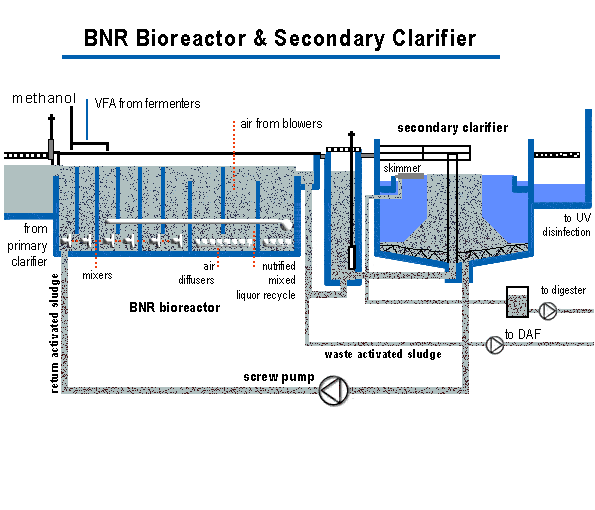
Disinfection
Clarified supernatant from the secondary clarifiers flows through the Ultraviolet (UV) light disinfection unit, and then discharged to the River.
Clarified supernatant from the secondary clarifiers flows through the Ultraviolet (UV) light disinfection unit, and then discharged to the River.

Wastewater is mainly divided into two categories, one is domestic wastewater from household activities, and the other is industrial wastewater produced by industrial or commercial use. The rapid development of the contemporary economy has also led to an increase in the amount of wastewater, Wastewater testing
ReplyDeleteHii.I completely agree with this blog.water is essential for each and everyone Nowadays.In many parts of the world, water is not safe enough to drink.so i prefer always best
ReplyDeletewater testing services in india.
The blog has been written very well, is very much informative if you need an ultra filtration plant in India to be installed at your place then we are here at clear Ion for that.
ReplyDelete